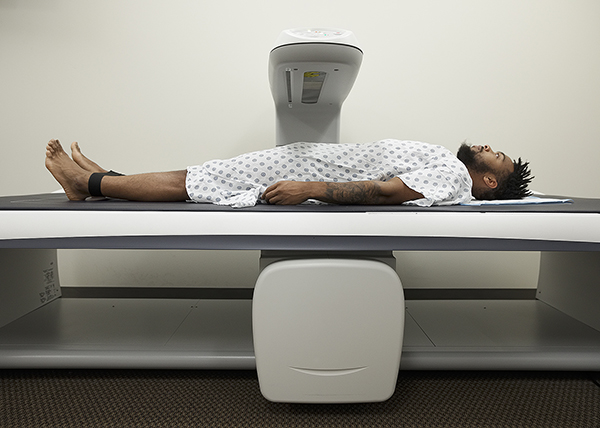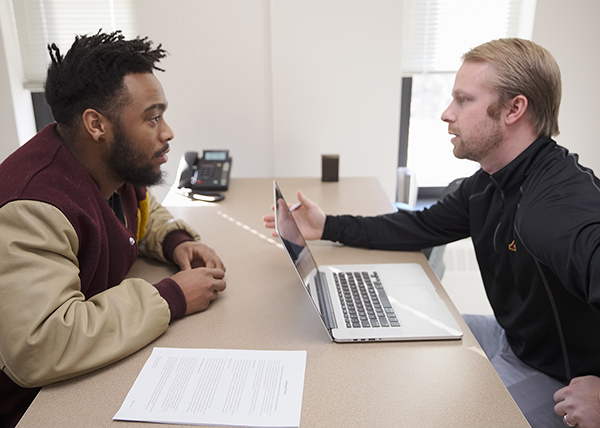Former Gopher football defensive back Cedric Thompson, ’15, was with the New England Patriots last year when he got a tip from a nutritionist. DXA scans, used for decades to measure bone density, were a new tool in developing strategies for athletic improvement, from nutrition to workouts.
With a little research, Thompson quickly learned that his very own alma mater had a DXA scanner as well as one of the nation’s leading experts in sport analytics. He contacted kinesiology professor Don Dengel, who introduced Thompson to research scientist Tyler Bosch, ’14.
Soon Thompson was back in Minnesota, unfolding his six-foot frame on the table of a DXA scanner at the U, then viewing the results with Bosch. What he learned allowed him to revise his training and nutrition in ways that would support his position as a safety, where speed is critical.
“The first time I went back to training, the coaches and everybody noticed,” says Thompson. “It was like night and day.”

Now in Minnesota with the Vikings, Thompson recently met with Bosch for another DXA scan and consultation. He saw where he’s made progress and talked about more specific areas to focus on for improvement.
“The most important thing is seeing in depth—legs, arms, torso,” says Thompson.
Bone, muscle, fat
DXA—short for dual x-ray absorptiometry—is the most accurate way to determine body composition. It relies on a dose of x-rays lower than spending a sunny day outside in Minnesota or flying to Los Angeles. Used medically for years to determine bone mineral density, DXA also measures muscle and fat.
A scan can measure different segments of the body to compare upper versus lower body or potential asymmetries between the right and left sides. These measures can be used to look at locations of past injuries or risk factors—valuable information to athletes and their organizations. About 10 years ago, an NFL team began using DXA and soon realized the scans were producing far more data than they knew how to use. The device maker referred the team to Dengel, who had been working with DXA scanners for more than 25 years.
“The team had a thousand scans at the time—13 pages per player,” says Dengel. It was a unique data set that included 350 first-year players. That’s when he turned to new doctoral student Tyler Bosch, a Fargo native and multi-sport athlete himself who’d come from opening and directing a sports performance center in Chicago. On the floor next to Bosch, the stack of scans stood waist high. “We started looking at the numbers and—wow.”
Dengel and Bosch worked with the data, creating normative values for different player positions, from quarterback to defensive line. They were soon able to determine distinct positional body types of players that make a roster and contribute over time. They developed an algorithm and, with each new scan, kept improving it to identify ideal body types for each position.

“So much of sport is trying to understand what the body can do without a good understanding of what the body is,” Bosch says. “Two numbers we usually know are weight and BMI (body mass index), but neither tells you the type and distribution of your mass. Increasing mass does not equal increasing performance. With DXA we were able to look at 200 variables.”
Teaching a class on sports movement technology, from video to DXA, Bosch got to know Gopher strength and conditioning coaches. That led to making DXA available to several Gopher teams—beyond football to men’s basketball and hockey and women’s volleyball and track and field.
Bosch completed his Ph.D. in just three years (“Two kids under two will do that to you,” he notes wryly) and took a two-year postdoctoral position in the Medical School with endocrinologist Lisa Chow. His project focused on understanding the effects of exercise training on skeletal muscle lipid metabolism—how the muscle uses fat. Meanwhile, he continued doing analysis with Dengel and visiting the NFL team partner.
From algorithm to start-up
Dexalytics was born when Dengel and Bosch joined forces with CEHD’s Educational Technology Innovations (ETI) last year. With funding from ETI, they were able to develop their algorithm into software that can be purchased by teams and sports organizations anywhere.
Dexalytics provides scores in the context of positions and teams—valuable information for coaches and support staff as well as recruiters and the athletes themselves.
“The unique thing is scoring the body in its ability to handle on-field demands,” says Bosch. “Dexalytics gives hard numbers to that.”
Dengel hopes to see Dexalytics used to keep athletes healthy—for example, in sports like gymnastics in which weight loss is a risk factor. He stresses that he does sports analytics, not coaching—or business.
“ETI took over the job of creating the business end of this,” says Dengel with a grin. “This allows me to focus on the research that drives Dexalytics and on what comes next.”
Next up is Dexalytics for the general population—providing the ability to analyze body composition based on what an individual wants to do, from losing weight safely to recovering from an injury, avoiding frustration and better understanding one’s own body.
Learn more about Dexalytics and ETI.
Story by Gayla Marty | Photos by Greg Helgeson | Spring/Summer 2017
